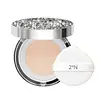What's inside
What's inside
 Key Ingredients
Key Ingredients

 Benefits
Benefits

 Concerns
Concerns

 Ingredients Side-by-side
Ingredients Side-by-side

Water
Skin ConditioningGlycerin
HumectantCaprylic/Capric Triglyceride
MaskingNiacinamide
SmoothingCetearyl Alcohol
EmollientPotassium Phosphate
BufferingCeramide NP
Skin ConditioningCeramide AP
Skin ConditioningCeramide EOP
Skin ConditioningCarbomer
Emulsion StabilisingDimethicone
EmollientCeteareth-20
CleansingBehentrimonium Methosulfate
Sodium Lauroyl Lactylate
EmulsifyingSodium Hyaluronate
HumectantCholesterol
EmollientPhenoxyethanol
PreservativeDisodium EDTA
Dipotassium Phosphate
BufferingCaprylyl Glycol
EmollientPhytosphingosine
Skin ConditioningXanthan Gum
EmulsifyingPolyglyceryl-3 Diisostearate
EmulsifyingEthylhexylglycerin
Skin ConditioningWater, Glycerin, Caprylic/Capric Triglyceride, Niacinamide, Cetearyl Alcohol, Potassium Phosphate, Ceramide NP, Ceramide AP, Ceramide EOP, Carbomer, Dimethicone, Ceteareth-20, Behentrimonium Methosulfate, Sodium Lauroyl Lactylate, Sodium Hyaluronate, Cholesterol, Phenoxyethanol, Disodium EDTA, Dipotassium Phosphate, Caprylyl Glycol, Phytosphingosine, Xanthan Gum, Polyglyceryl-3 Diisostearate, Ethylhexylglycerin
Water
Skin ConditioningCI 77891
Cosmetic ColorantPhenyl Trimethicone
Skin ConditioningIsononyl Isononanoate
EmollientButylene Glycol
HumectantCyclopentasiloxane
EmollientGlycerin
HumectantPentaerythrityl Tetraethylhexanoate
EmollientCetyl PEG/PPG-10/1 Dimethicone
EmulsifyingCaprylic/Capric Triglyceride
MaskingMica
Cosmetic ColorantCyclohexasiloxane
Emollient1,2-Hexanediol
Skin ConditioningDisteardimonium Hectorite
StabilisingIsododecane
EmollientBis-PEG/PPG-14/14 Dimethicone
EmollientAcrylates/Polytrimethylsiloxymethacrylate Copolymer
Skin ConditioningMagnesium Sulfate
Stearoyl Inulin
EmollientCI 77492
Cosmetic ColorantGlyceryl Tribehenate/Isostearate/Eicosandioate
EmollientChlorella Vulgaris Extract
Skin ConditioningGlucose
HumectantPolyglyceryl-2 Diisostearate
EmulsifyingGlyceryl Caprylate
EmollientAluminum Hydroxide
EmollientFructooligosaccharides
HumectantFructose
HumectantCI 77491
Cosmetic ColorantTriethoxycaprylylsilane
Dimethicone
EmollientCetearyl Dimethicone/Vinyl Dimethicone Crosspolymer
EmollientEthylhexylglycerin
Skin ConditioningCentella Asiatica Extract
CleansingChamomilla Recutita Flower Extract
MaskingAluminum Dimyristate
Emulsion StabilisingCI 77499
Cosmetic ColorantParfum
MaskingTrisodium Ethylenediamine Disuccinate
Ceramide NP
Skin ConditioningPanthenol
Skin ConditioningPentaerythrityl Tetra-Di-T-Butyl Hydroxyhydrocinnamate
AntioxidantCentella Asiatica Leaf Extract
Skin ConditioningWater, CI 77891, Phenyl Trimethicone, Isononyl Isononanoate, Butylene Glycol, Cyclopentasiloxane, Glycerin, Pentaerythrityl Tetraethylhexanoate, Cetyl PEG/PPG-10/1 Dimethicone, Caprylic/Capric Triglyceride, Mica, Cyclohexasiloxane, 1,2-Hexanediol, Disteardimonium Hectorite, Isododecane, Bis-PEG/PPG-14/14 Dimethicone, Acrylates/Polytrimethylsiloxymethacrylate Copolymer, Magnesium Sulfate, Stearoyl Inulin, CI 77492, Glyceryl Tribehenate/Isostearate/Eicosandioate, Chlorella Vulgaris Extract, Glucose, Polyglyceryl-2 Diisostearate, Glyceryl Caprylate, Aluminum Hydroxide, Fructooligosaccharides, Fructose, CI 77491, Triethoxycaprylylsilane, Dimethicone, Cetearyl Dimethicone/Vinyl Dimethicone Crosspolymer, Ethylhexylglycerin, Centella Asiatica Extract, Chamomilla Recutita Flower Extract, Aluminum Dimyristate, CI 77499, Parfum, Trisodium Ethylenediamine Disuccinate, Ceramide NP, Panthenol, Pentaerythrityl Tetra-Di-T-Butyl Hydroxyhydrocinnamate, Centella Asiatica Leaf Extract
 Reviews
Reviews

Ingredients Explained
These ingredients are found in both products.
Ingredients higher up in an ingredient list are typically present in a larger amount.
This ingredient is an emollient, solvent, and texture enhancer. It is considered a skin-softener by helping the skin prevent moisture loss.
It helps thicken a product's formula and makes it easier to spread by dissolving clumping compounds.
Caprylic Triglyceride is made by combining glycerin with coconut oil, forming a clear liquid.
While there is an assumption Caprylic Triglyceride can clog pores due to it being derived from coconut oil, there is no research supporting this.
Learn more about Caprylic/Capric TriglycerideCeramide NP is a type of ceramide.
Ceramides are intercellular lipids naturally found in our skin that bonds dead skin cells together to create a barrier. They are known for their ability to hold water and thus are a great ingredient for dry skin.
Ceramides are an important building block for our skin barrier. A stronger barrier helps the skin look more firm and hydrated. By bolstering the skin ceramides act as a barrier against irritating ingredients. This can help with inflammation as well.
If you would like to eat ceramides, sweet potatoes contain a small amount.
Read more about other common types of ceramides here:
Ceramide AP
Ceramide EOP
Dimethicone is a type of synthetic silicone created from natural materials such as quartz.
What it does:
Dimethicone comes in different viscosities:
Depending on the viscosity, dimethicone has different properties.
Ingredients lists don't always show which type is used, so we recommend reaching out to the brand if you have questions about the viscosity.
This ingredient is unlikely to cause irritation because it does not get absorbed into skin. However, people with silicone allergies should be careful about using this ingredient.
Note: Dimethicone may contribute to pilling. This is because it is not oil or water soluble, so pilling may occur when layered with products. When mixed with heavy oils in a formula, the outcome is also quite greasy.
Learn more about DimethiconeEthylhexylglycerin (we can't pronounce this either) is commonly used as a preservative and skin softener. It is derived from glyceryl.
You might see Ethylhexylglycerin often paired with other preservatives such as phenoxyethanol. Ethylhexylglycerin has been found to increase the effectiveness of these other preservatives.
Glycerin is already naturally found in your skin. It helps moisturize and protect your skin.
A study from 2016 found glycerin to be more effective as a humectant than AHAs and hyaluronic acid.
As a humectant, it helps the skin stay hydrated by pulling moisture to your skin. The low molecular weight of glycerin allows it to pull moisture into the deeper layers of your skin.
Hydrated skin improves your skin barrier; Your skin barrier helps protect against irritants and bacteria.
Glycerin has also been found to have antimicrobial and antiviral properties. Due to these properties, glycerin is often used in wound and burn treatments.
In cosmetics, glycerin is usually derived from plants such as soybean or palm. However, it can also be sourced from animals, such as tallow or animal fat.
This ingredient is organic, colorless, odorless, and non-toxic.
Glycerin is the name for this ingredient in American English. British English uses Glycerol/Glycerine.
Learn more about GlycerinWater. It's the most common cosmetic ingredient of all. You'll usually see it at the top of ingredient lists, meaning that it makes up the largest part of the product.
So why is it so popular? Water most often acts as a solvent - this means that it helps dissolve other ingredients into the formulation.
You'll also recognize water as that liquid we all need to stay alive. If you see this, drink a glass of water. Stay hydrated!
Learn more about Water